Nobuyuki OSAKI
Meditating about myself and others. About memory and perception. About the reality of all of us, living in the information society. And also meditating about politics, society and unpredic- table disasters, about our future. The more I think about it, the more "this world" is flooded with vagueness and uncertainties, in my opinion.That isn't meant to be negative at all. The vague and uncertain state presents a possibility floating to the unknown, in my opinion. I use myself like a coordinate axis, I meditate about this feeling of "vagueness" and "uncertainty" and ask myself about the existence and possibility of this world.
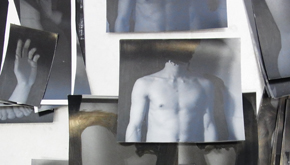 作品素材、1997-99年頃 作品素材、1997-99年頃
私にとって「この世界」は、あいまいさや不確かさで溢れている。
美大生の20歳の頃、セルフタイマーで自身のヌードを撮影した。理由は素材として手や足といった人体の写真が必要で、自由の利くモデルが自分しかいなかったからだ。沢山の写真を撮影し、それらの写真を眺める中で、ふと不思議な感覚に気がついた。それは、写真に写る「自分」について、私は自分ではない別の「何か」を見ているような感覚を持っていたのだ。私はそのような契機から「自分とは何か」「自分を取り巻く世界とは何か」という探究心を持ち、「この世界」について考えている。
自身と他者について考える、記憶や認識について考える、情報社会の中で生きる私たちのリアリティについて考える、また、政治や社会、予測できない天変地異など、私たちのこれからの未来について考える。
考えれば考えるほど、私にとっての「この世界」とは、あいまいさや不確かさで溢れているのだ。
これは決してネガティブではなく、その「あいまいさ」や「不確かさ」といった状態は、私が世界を捉えるにあたって、流動的な未知への可能性である。
私は自身の存在を座標軸として、この「あいまいさ」や「不確かさ」の感覚について思考し、世界のありかたとその可能性について問いかけている。
|
In my opinion, "this world" is full of vagueness and uncertainties.
When I was 20 years old and studying art, I took nude pictures of myself, using the autotimer. I needed pictures of human extremities for my work and I was the only model available.
I took countless photos and while I was looking at them, I experienced a strange sensation. While looking at "me" on the pictures, I felt like I was looking at "something” else, something that wasn’t me. I’ve been asking myself "What am I?" and “What is the world around me?" ever since, and I've been thinking about "this world".
Meditating about myself and others. About memory and perception. About the reality of all of us, living in the information society. And also meditating about politics, society and unpredictable disasters, about our future. The more I think about it, the more "this world" is flooded with vagueness and uncertainties, in my opinion.That isn’t meant to be negative at all. The vague and uncertain state presents a possibility floating to the unknown, in my opinion.
I use myself like a coordinate axis, I meditate about this feeling of "vagueness" and "uncertainty" and ask myself about the existence and possibility of this world.
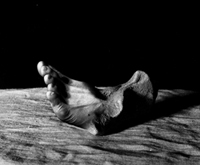 Object 1997, gelatin silver print Object 1997, gelatin silver print
|
うすれゆく記憶 — 漂白するイメージ
悪夢の中のように情景は変化する。それは、とてもゆっくりと始めはほとんど分からないように形状が揺らぎ、色彩が躍動し、流れて、消え去っていく。かなり技術的な手間を施しつつも、あたかも当然であるかのように見せる大崎のぶゆきの「溶けていく世界」の作品群では確かさの喪失を示している。
知覚を理論的に観賞してみると、この揺らぎや消滅の現象は、常にとてもゆっくりと画面上のいくつかの点から発生しているのが興味深い。せっかちな鑑賞者なら、変化の前に耐えきれずもうそっぽを向いてしまっているだろう。ごく普通の出来事や言葉が持つ不可解さは、より長い時間をかけて、観察し、熟考することではじめて明らかになる。まるで日常を効率よく理解するためにはそうする過程が必要であるように。ドイツの映画監督アレクサンダー・クルーゲ(Alexander Kluge)は、かつて次の文章を取り上げた。「言葉を近くで見れば見るほど、言葉は遠くから見返してくる」。これは、確かに映像にも言えることである。ここでは、大きな画面上で起こる出来事はループになっていて、それが既に慰めの行為となっている。つまり、壁紙の模様と文字が、ポートレイトと風景画が、それら全てが消滅した後また元の状態を作り上げる。
物理学者は、全ての物質の本質が空間から構成されていて、エネルギーの場においてのみ存在することを知っている。また、我々の視覚的な認識が客観的ではなく、脳の経験によって初めて作られるものであるということも知っている。だとしても、世界の秩序を明確な輪郭のない現実と捉えるのは耐え難いものだ。大崎の作品では、普段は確固としたものと認識されている構造が溶解していく様を目の当たりにさせられるのは驚きであり、またいくらか不安にさせるものでもある。 — 例えば、ホテルの一室で華美なバロックもどきの壁紙装飾があり、時にはそれが無ければ良いのにと、望む人がいたとしても。 「ART OSAKA 2014」(於:ホテルグランヴィア大阪)で大崎のぶゆきは、実際のホテルを使って作品を発表した。まず、通常なら普通の家具が設置された客室の6031号室に、あの青と白い植物の装飾を壁紙として、作品《dimension room》を作り、その前には大きな画面が掛けられ、壁紙と同じものを見ることができた。そして、それは始めほとんど気づかない速度で動き始め、やがて変化し、溶けていった。バスルームでは、作品《Portraits》が展示された。あたかも、シャワーの下で洗い流されているかのように。しかし、ここで問題なのはシュールレアリスティックなショックや、暗く装飾されたホテルでの一夜の息苦しさを体験するとかでもない。明確な境界がなくなることは、記憶の現象ともいえる。そして、記憶の構造とメカニズムは、大﨑のさらなる作品領域でもある。記憶は往々にして不鮮明であり、あいまいで、はっきりとしていない。それは時間の流れの中で消えてなくなる。ローマにあるプロテスタントの墓地には、「その名を水に書かれし者ここに眠る」こう記された墓石がある。逆説的にもこれが1821年2月23日に26歳足らずで亡くなったロマン派の詩人ジョン・キーツの墓であることは非常にはっきりと記憶されている。
もちろん正確ではっきりとした記憶もある。しかし、それは間違っているか、或は個々の写真又は夢中に崇拝している物と関連付いて、記憶の中の出来事とは決して等しくない明るい記憶として保存されていることが往々にしてある。そのように考えると、過去に対してかなり相対的な現実を受け入れるのは容易に想像出来ることかもしれない。ただ、これが今現在にも通用すべきであるという事実は、より耐え難いことである。ただし、知覚の相対性に関する知識。そう、現実の相対性に関する知識は、何かしらの満足感を与える要素を持つことができる。すなわち、社会の秩序と強い規制を 、特に日本では少しでも柔らかくしたいという願いもあるのかもしれない。そう見えていることが実際とは違っているとき、創造的に全てを変え、新たに決めることもできるのだ。
Hajo Schiff ( ハヨ・シフ /美術批評) |
Memories fade – So do Images
Like in a nightmare, the surroundings change: Very slowly and hardly recognizable at first, shapes and colors appear to come alive, begin to melt and then fade away. With considerable technological effort and yet with seemingly natural ease, Nobuyuki Osaki displays, in his work series “Melting World”, the loss of certainties.
In terms of perception theory, it is interesting that this blurring and vanishing always commences at merely a few points of the picture and proceeds very slowly – quick observers have already turned away, before the irritation begins. One recognizes that the mysteriousness of common things, or even words, begins only upon longer observation, consideration and pondering than what is required for the usual, efficient perception in everyday life. The German filmmaker Alexander Kluge had once pointed out: “The closer one looks at a word, the further it looks back.” Of course, this can be applied to images just as well. It is, then, of some comfort that the occurrences seen on the flat screens are a loop: The wallpaper patterns and graphic characters, portrait heads and landscapes – after their disappearance they all recompose themselves to attain the original state.
Though physicists know that all matter essentially is made up of interstices and can exist merely through fields of energy, even though our visual perception is not objective and is constructed only through the experience of the brain: It is difficult, almost unbearable, to conceive the order of the world as a reality without firm contours. It is surprising and perhaps somewhat alarming to experience in the work of Nobuyuki Osaki the dissolution of what we normally perceive as unyielding structures – even if one may wish, for example in a hotel room with obtrusively colored mock-baroque wallpaper, that some things would simply disappear from view. At the “Art Osaka 2014” (location: Hotel Granvia Osaka), Nobuyuki Osaki profited from the possibility to stage his art in a real hotel: The otherwise normally furnished room 6031 was entirely fitted with a blue-and-white plant ornament wallpaper. Hung on the decorated walls were large flat screens featuring the same wallpaper – and this began, barely noticeable at first, to move, to waver and to melt. In addition, a portrait head dissolving in water, as if it were being washed away under a shower, was presented in the bathroom. But it is not just about the surreal shock, not just about potentially nightmarish experiences in a dark hotel night.
The fading of distinct boundaries also is a phenomenon of memory. The structures and mechanisms behind memory are another of Nobuyuki Osakis work fields. Memory often is blurred, vague, simply washed out... it is lost in the stream of time. Engraved on a tombstone at the protestant cemetery in Rome are the words: “Here lies One Whose Name was writ in Water.” Paradoxically, one recalls quite clearly that this is the grave of the romantic poet John Keats, who died on 23 February 1821 at the age of just under 26.
Surely, there also are memories that appear crystal clear and precise. Nevertheless, they frequently are wrong or refer to single photos or fetishized things, conserving a wishful memory, one that has never corresponded to the actual incident. This considered, it may suggest itself to accept a rather relative reality for the past – but that such a notion should be valid for the present is already more difficult to accept. However, the knowledge of the relativity of perception, indeed of reality itself, could also have a liberating effect: Perhaps there exists a longing to soften the order and severe regulation of a given society a bit, particularly in Japan. Moreover, if nothing really is as it seems, then everything can be creatively altered and redefined.
Hajo Schiff (art critic)
|
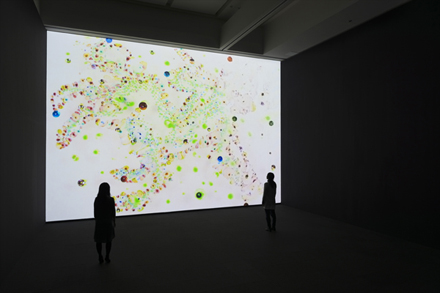
CONSTELLATIONS (Museum of Contemporary Art Tokyo, 2015) Photo: Ken Kato
混沌の中から生まれるもの-大﨑のぶゆき
ふたご座、いて座、おとめ座―見たことのある星座が現れてはゆっくりと溶けていく。形あるものが、まるで結び目がほどけるように解体していく過程は、不思議な浮遊感を漂わせている。19種にも及ぶ星座が次々と現れては消え、そしてまた現れる。そのループ構造の連続性の中に鑑賞者が身を置く時、星座が消えてゆくのか、あるいは生成していくのか、始まりと終わりの境目が次第に溶けあうような感覚が訪れる。
この映像から目が離せなくなるのは、溶けてゆく星座たちがどれも異なる動きを見せるからである。作家は、CGを用いることなく実写にこだわりこの作品を仕上げている。まず水溶性の透明シートに水性のぺンで星座の絵を描きそれを水面に浸し、刻々と移り変わる様をビデオカメラに収めていく手法を取る。したがって溶けていく過程は、作家もコントロールすることはできず、不意に画面が揺らぐこともあり、溶け出す方向にも速度にも一貫性はない。夜空のファンタジーのように見えたものは、全ては水の中で、起こった出来事。リアルな記録である。
大﨑のぶゆきは、目の前にある現実と私たちが現実と認識しているものとのズレを可視化させてきた作家である。学生時代に等身大のセルフポトレイトを制作した時、自分が認識している自己の姿と作品を通して見えてくる自分との微妙な差異や齟齬に気づきその違和感を起点に「今見ている世界は本当なのか」と作品を通して聞い続けてきた。もちろん私たちは自分自身もそして世界も、ありのままに捉えることなどできない。各自が自分の中に幾つものフィルターを持ち、脳内で細かな補正を繰り返しながら自分だけの現実をつくり上げている。認知科学ではすでに常識となっているこうした前提は、普通の生活を営む私たちにも実感になりつつあり、例えばネットの中でごく普通の人々の生のつぶやきに触れる時、自分と他者との世界観が微妙にズレていることに日々気づかされる。同時代を生きながらも100人いれば100 通りの世界があり、絶対はなく確かなものはないという事実を大﨑はあらためで顕在化させその「不確かさ」 の中に鑑賞者を誘い、そして囲い込んでいく。
学生時代に山中で見た星空の記憶をもとに制作された本展出品作《water drawing-stardust-》は、満天の星空を前にすることで逆に星座がみつからなくなってしまう状況に着想を得たものである。そもそも星座は古代人の想像の産物であり、それぞれの星には科学的な関連性があるわけではない。本来無関係であるはずの星々を既定の形をなぞり線で結ぼうとすることには困難さが伴い、見えるような見えないような不確かな状況に身を置くことになる。そうした記憶を共有している多くの人々にとって、本作品はある種の解放感とカタルシスをもたらすであろう。しかし一方で私たちの脳は、イメージが消失しクリアになっていく画面の中から、なお消えたイメージを探そうとし、そこに新たな像を再構成しようとする働きを止めることはない。秩序からカオスへ。そしてカオスからまた秩序へと繰り返される生命体にも似た循環構造。大﨑がつくり上げたループの中で、私たちはここで、自分にしか見えない新たな星座を脳裏に描き出す。
森 千花(もり・ちか/東京都現代美術館 学芸員)
「未見の星座」展(東京都現代美術館、2015年) 展覧会カタログより
|
Something which arises from chaos – Nobuyuki Osaki
Gemini, Sagittarius, Virgo... Images of familiar constellations appear, then slowly dissolve. The process of these forms, once solid, being deconstructed appear like knots unraveling and evoke a strange feeling of floating. A total of nineteen constellations appear in succession, then disappear, and the process is repeated over again. Unable to determine whether the constellations are disappearing or being formed, the viewer suspended in this looped repetition is overcome by the feeling that beginnings and ends are gradually merging and blending together.
The reason why we cannot take our eyes off this video by Nobuyuki Osaki is because every dissolving constellation shows a different movement. To create these images, the artist did not employ computer graphics but insisted on live-action filming. First, he illustrated the constellations on transparent water-soluble sheets using water-based pens, then soaked the drawings in water, and filmed the images melting away using a video camera. Hence he has no control over the way the pictures melt – the drawing surface can suddenly jolt and the direction and speed of the melting process are never consistent. What appears to be a fantasy unfolding in the night sky is in fact something that happened under water. The video is a document of a real happening.
Through his art, Osaki visualizes the gap between the reality before our eyes and our understanding of reality. When Osaki created a life-sized self-portrait during his student days, he noticed the slight difference and discrepancy between how he perceives himself and the self-image that surfaces from his work. This sense of discomfort has led Osaki to continuously pose the question – is the world I am now seeing real? It goes without saying that we can never perceive ourselves as we are, nor the world as it is. Each of us creates our own reality by making small adjustments to the information we process through the many filters in our brains. In cognitive science, this is already a basic understanding of how our mind operates. We have now come to accept this as a given in our daily lives too – for example, when we come across live tweets posted by ordinary Internet users, we realize that we each have slightly different views of the world. Osaki reaffirms the fact that living in the same time does not mean living in the same world – one hundred people means that there are one hundred versions of the world – and that nothing is absolute or definitive. Osaki invites audiences and encloses them into this sense of “uncertainty”.
The work water drawing -stardust- presented in this exhibition is based on Osaki's recollection of his student days, looking at the starry sky in the mountains. The work was inspired from the kind of situation where a star-filled sky conversely clouds the eyes from recognizing constellations. Constellations are, of course, figments of man's imagination from centuries ago; individual stars are by no means scientifically connected to each other. To try and connect random stars based on predetermined pictures, therefore, is a challenging task, which leaves the viewer in an ambiguous situation suspended between seeing and not seeing. For many of us who remember being in a situation like this, Osaki's work offers a certain sense of liberation and catharsis. At the same time, however, even as the images disappear and the screen becomes clear, we cannot stop our brains from searching and reconstructing new images. Moving from order to chaos, and once again, from chaos to order, the cyclic structure of the work resembles the recurring cycle of life forms. Inside the loop Osaki has created, our minds map out new constellations that are present only in this place, only to ourselves.
Chika Mori (Curator, Museum of Contemporary Art Tokyo)
In the catalogue of CONSTELLATIONS (Museum of Contemporary Art Tokyo, 2015)
|
大﨑のぶゆき 「Display of surface-不可視/可視/未可視」
《Display of surface》は、大﨑のぶゆきが2004年から続けているシリーズ。初期の段階では、身の回りの日用品の表面に付着した指紋を検出したインスタレーションが発表されたが、近年は、より「絵画」の問題に引きつけ、「接触の痕跡」「イメージの認識」「時間」といった観点から「絵画」を捉え直す試みがなされている。
個展『-Display of surface- 「不可視/可視/未可視」』( 2015年、galerie 16 )では、展示されたキャンバスはいずれも、一見すると白の単色で塗られただけで、何も描かれていないように見える。だが作家によれば、実際には、ワセリンを指に付け、下地の上に手探りで描いているという。今回はカフカの小説『城』の登場人物が描かれているというが、それらは「不可視」の存在に留まっている。
では、指での描画、つまりキャンバスとの身体的接触の痕跡を「可視」化することは、どのようにして可能なのか。手がかりは、傍らに置かれた『城』の文庫本。持ち主が表紙に触れたことが、銀色に浮かび上がった指紋の痕跡によって示される。《Display of surface》シリーズにおける、潜在的な画像をはらんだ表面もまた、犯罪現場での鑑識捜査に用いられる指紋の検出方法を使えば瞬時に像が現われるのであり、あるいは酸化作用などの経年変化によって、何十年か後には自ずと像が顕在化するという。つまり、「不可視」は正確には「未可視」の状態にあるのだ。自然作用による像の顕在化までにかかる時間に耐えうるように、油絵の技法研究者の協力を得て、「表面が剥落せず、100年間もつ絵画」を制作するプロセスの記録映像も合わせて発表された。
このように《Display of surface》シリーズでは、可視的なビジュアルイメージではなく、身体との物理的接触によって「表面」で起こる出来事(の痕跡)として、「絵画」は唯物論的に了解されている。その接触の痕跡が未可視にとどまる状態は、むしろ写真の「ネガ」に近く、経年変化によって像が可視化されていくプロセスは、時間が極端に引き延ばされた「現像」と言えるだろう。その「現像」プロセスに、個人の生を超える時間的スパンを持ち込み、それに耐えうる下地を開発する大﨑の手つきは、両義的である。一方では、絵画という制度の「延命」を図りつつも、無造作に壁に立てかけられたキャンバスたちは、ただの白い板というモノにしか見えないからだ。
ポートレートや星座などの描画が水に溶け出し、おぞましさと美しさが同居する崩壊の過程を映し出した映像作品においても同様に、コントロールを手放した「時間的作用」がイメージの変容を駆動させる。本シリーズ作とは、イメージの消滅/顕現という点では逆向きのベクトルをなすが、絵具の層の堆積とは異なる「時間の相」と絵画の関係を考えることが、大﨑作品の基層の一つにあると言えるだろう。
高嶋 恵(たかしま・めぐみ/美術批評)
Webマガジン 「artscape」2015 年5月15日号 (DNP 大日本印刷)
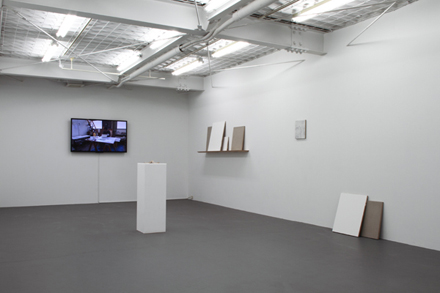
|
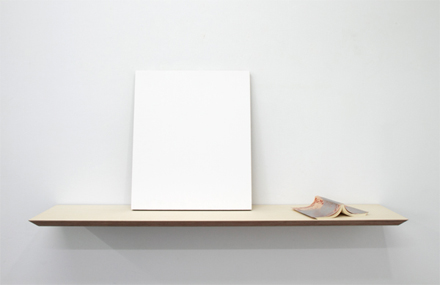
Nobuyuki Osaki “Display of surface – invisibility / visibility / non-visibility”
Since 2004 Osaki has been working on the series “Display of Surface”. The installations exhibited at the beginning secured fingerprints taken from everyday objects. Lately he has taken an interest to the complex of problems presented by the “painting”; he tries to comprehend paintings via the aspects of “trace of touch”, “perception of the visual image” and “time”.
Every canvas displayed during the solo exhibition “Display of surface – invisibility / visibility / non-visibility” (galerie 16, Kyoto, Japan, 2015) is painted in a white monotone, on first glance, there is nothing to be seen on them. The artist actually did paint several motifs with Vaseline on his fingertips on the primer, without being able to see anything. According to his words, there are protagonists from Kafka’s novel “The Castle” to be found there, but every single one of them is an “invisible” existence.
But how will this finger painting, this trace of touch, become “visible” on the canvas? The paperback of “The Castle” is a hint, it’s close by. The owner’s touch on the cover is shown as a silver fingerprint. So there is a drawing hidden on the surface of the “Display of Surface” series. If you used crime scene investigation methods, it would appear immediately. You could also simply just wait several decades. The picture will then appear according to oxidation and other aging changes. Consequently, this “invisibility” is actually a state of “non-visibility”. At the same time he also published a video about his creation of an oil painting, which will last for a hundred years with the help of a specialist for oil painting techniques. The painting will last through all these years until the drawing is finally revealed.
The painting in the “Display of Surface” series isn’t perceived as an actual, visual picture, but as the trace of an event which happened through physical contact with the surface. It is perceived in a materialistic way. The trace is in a state of non-visibility, similar to the negative of a photo. The “development” is extremely drawn out and it will take several decades until the picture finally appears. This development process might take longer than the average life expectation of a human being and Osaki developed the foundation so it’ll last through all this time. This is deeply ambiguous – because on one hand the longevity of the system “Painting” is increased, on the other hand these canvasses look just like plain white boards.
Another piece of Osaki’s video art shows melting portraits or constellations in water, depicting the process of destruction in which the grotesque and beauty can coexist. The uncontrollable “influence of time” also changes the picture here. Here, the picture disappears, going into the opposite direction of “Display of Surface”. One piece depicts the destruction, the other the genesis. You could actually say thinking about the relationship of paintings and their “state of time” – which is wildly different from piling up different layers of paint – is one of the most fundamental elements of Osaki’s art.
Megumi Takashima (Art critic)
Web magazine “artscape”, 15. Mai 2015 (Dai Nippon Publishing |
大﨑のぶゆき " Trace Trip, Time capsule"
人間はしばしば記憶ちがいを起こす。何かを思い出そうとするとき、脳は神経細胞に蓄えられた断片的な記憶を集めてそれを再構築するらしい。その際に、一部を変化させたり、変形させてしまうことが多々あり、誤った記憶が形成されるのだという。記憶がスタティックなものではなく、想像力による改変と再構築に絶えずさらされていること。大﨑のぶゆきの《Trace Trip, Time capsule》は、こうした脳科学の分野における知見をふと想起させるインスタレーションである。
大﨑が2013年から取り組んでいるこのシリーズは、映像やドローイング、アルバム写真、それらに関連するさまざまなオブジェなどから構成される作品で、ひとりの友人へのインタビューをもとに、想い出の場所を実際に訪れたり、写真に残された風景を探したりといったリサーチによって組み上げられたものだ。大﨑は、リサーチの過程で友人の記憶と実際の現実との間の齟齬や差異を発見し、それを自らの想像で「修復(Reparature)」することで、他者の記憶を新たな物語へと変貌させている。記憶と現実の間のズレは、作家が介入し他者の記憶を美術作品として成立させる要のポイントとなっているが、一方で、過去の出来事を思い出すという行為が、不確かな記憶の断片を寄せ集め、想像力によって再構築することである証左ととらえることもできるだろう。大﨑はこの無自覚的なプロセスを積極的に開示しようとしているように思える。
この点で、一連の作品に「タイムカプセル」というタイトルが与えられていることは興味深い。個人的な記憶を作品化しマルチプル・エディションとして分散させることで、タイムカプセルとして機能させる試みであるという企図をふまえるならば、それを開けるのはインタビューされた友人もその記憶も知らない未来の誰かかもしれない。その誰かは、由来や状況の不確かな写真や物を組み合わせ、想像しながらその記憶の全体像を再構築することになる。インタビューで語られた記憶が曖昧な断片に還元され、それを目にした者が自らの記憶や経験も重ね合わせながらおのおのの物語を想像するという、多重に折り重なった構造が仕組まれている点に、大﨑が一貫してテーマとする「不確かさの感覚」が凝縮されている。
大浦 周(おおうら・いたる/埼玉県立近代美術館 学芸員)
芸術批評誌『REAR』 No34. (リア制作室、2015年)
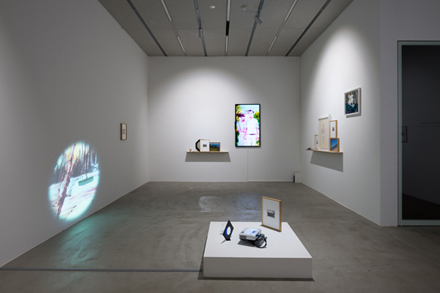
|
Nobuyuki Osaki “Trace Trip, Time Capsule”
Human recollection sometimes fails. When we are trying to remember something, the brain will assemble the fragments of memory saved in neurons, and reconstruct them. More often than not, some fragments are changed or tampered with. This way, a tampered memory is born. Memories are not static, they can always be restructured or changed by our imagination. Nobuyuki Osaki’s installation “Trace Trip, Time Capsule” makes use of this insight of cognitive science.
Osaki has been working on this series since 2013, which consists of diverse works such as video art, drawings, photo albums and relevant objects. He also did extensive research for this series; he interviewed a friend, for example, visited the places of her memories and searched for the landscapes in her photos. During his research, he noticed several differences and contradictions between memory and reality, and “repaired” them with his own imagination. He created a new story from the memories of strangers.
This difference between memory and reality is pivotal. It completes this work of art by combining the memories of strangers with the interfering artist. At the same time, it acts to prove that thinking back to past events is nothing but reconstructing imprecise fragments of memory by imagination. It seems that Osaki attempts to bring this unconscious process to light.
It is an interesting fact this series was named “Time Capsule” in this regard. Personal memories are spread as art in multiple editions, which turns them into time capsules. But this time capsule could be opened in the future by someone who neither knows the interviewed friend nor her memories.
And this someone now tries to find connections between photos and objects without any background knowledge, and reassembles the overall picture with imagination. The memories told in the interview become vague, single fragments and the viewer connects them to his or her own memories and experiences to imagine their story. In this multi-layered structure, you can find the “perception of impreciseness”, Osaki’s consistent theme.
Itaru Oura (Curator, Museum of Modern Art, Saitama)
Art Magazine “REAR”, issue 34, 2015
|
美術手帖Web REVIEW 2019.12.25
https://bijutsutecho.com/magazine/review/21116
日系移民の思い出と記憶を多層的に内包する作品群。「大﨑のぶゆき:ブエノスアイレス」展 : はがみちこ評
「アルゼンチンは日本の未来ではないか」
「イメージの流れ消える絵画」を手掛けてきた大﨑のぶゆきは、近年は自分や特定の誰かの個人的記憶を手がかりに、「見る」ことをめぐる認識論的な問いや記憶の曖昧さを喚起させる作品群を発表している。さらにその延長として、「ブロック宇宙論」(宇宙は4次元時空のブロックにすべて納められているとみなす)や「スポットライト理論」(時間の流れを認知することは、4次元ブロックのなかをスポットライトが移動するようなものと説く)といった最新の現代宇宙論におけるいくつかの仮説にヒントを得て、複数の時空(過去・現在・未来)の記憶を同一作品内に表そうとする「マルチプル・ライティング」なるアイデアを展開する。
本展はこの近年の制作上のコンセプトをベースに、ブエノスアイレスでのレジデンスにて、アルゼンチン日系移民をルーツに持つ人々に対し、彼らの思い出について取材を行うことで構想されたものだ。自らを取り巻く世界の成り立ちの"ユニバーサル"な地平に向けられたその態度は、彼らを描くにあたり「日系移民」という特異性を無効化する契機を狙う。その契機とは「普通」に還元することだ。
《Portraits(ブエノスアイレス | 日系移民のポートレイト)》はインスタレーションによって群的に示される作品である。中心のモニター3台には、水溶性絵具を用いた彼の手法によって、ブエノスアイレス日亜学院の生徒の肖像写真を描いたポートレイトが溶けていく映像が写され、周囲には彼が取材した人々の実際のポートレイト写真が配されている。当然ながら日本人らしい顔立ちをしている彼らの写真は、一見すると、日本の家庭のスナップ写真のようでもある。
しかし、会場に流れる音声は、彼が聞き取りした女性たちによるスペイン語の会話の録音だ。展示内でその翻訳は示されないので、スペイン語が聞き取れる人でなければ内容はわからず、そのディスクリプションのなさは、むしろ日常のなかでありえるだろう状況(外国語を話す日系移民の人に出会う)と同じ体験を鑑賞者に与える。おそらくそれは、大﨑がこの会話を最初に耳にしたときと通じる状況だ(彼はスペイン語を理解しない)。配布テキストでは、音声が日系の双子姉妹が2人の思い出について話す会話であること、そのインタビューの内容によって大﨑が個人的な随想を深めたことが示唆されている。これを読んでもやはり、鑑賞者は、肝心な会話の内容自体に辿り着くことができないが、それは大﨑が彼女たちの話す思い出自体に辿り着けない(もし彼が内容を理解したとしても、それを共有したことにはならない)ことに等しい。こうした他者の記憶が不可触である「普通さ」、あるいは「転写」が作品体験のなかに仕組まれることで、視覚を通じて展開されてきた大﨑の関心が「聞く」ことの曖昧さへと拡張されている。
《untitled album photo》シリーズは、取材した人々のアルバムの日常的な写真をモチーフに、同様に水溶性の絵画の溶ける様子を撮影した「記憶」のアーカイブとしての写真作品だ。小サイズのインスタント写真(チェキ)の組作品では、個人に固有なものとしての記憶を匿名的な集合として示すいっぽう、フィルムからの現像(Cプリント)の大型作品では、個を超えて複数性へと開かれる記憶を象徴的に示す。
大﨑は、個人の記憶は「ユニークピースでありマルチプル」であると述べ、他者の記憶の固有性への触れられなさと同時に、「自分自身とつながって転写していく」感覚、「なんともいえない時空を超えてつながっていく感覚」が確かにあるとして、冒頭で述べたような現代宇宙論への近接を体感的に説明する。誰かの記憶を描いた絵画が、融解して移り変わる様を見る。特別でありながら何気ない誰かの会話を、その内容を知ることなしに聞く。それらの曖昧な体験のなかに、この時空に入り込むための仕掛けが試みられているのだろう。
いくども財政恐慌に陥り、現在進行形でインフレが加速するアルゼンチンで、さして大きな混乱もなく普通の生活を営む人々に触れた大﨑は、日本とアルゼンチンにまつわる対称性(真反対)から、「アルゼンチンは日本の未来ではないか」というSF的ともいえる直感を、彼独自の理論により導き出したという。ゆえに、ここで大﨑がとらえようと試みたのは、自らとかけ離れた(アルゼンチンの)人々の過去ではなく、自ら(日本)の未来についてであるらしい。
《日時計(-34°)》は、大﨑がアルゼンチンで撮った写真の額に、一角が-34°(アルゼンチンの緯度、日本の緯度が35°になるためちょうど地球の真裏にあたる)の三角形のUVカット・アクリルをはめ込んだものだが、日時計が太陽光によって影を落とすように、UVカットされていない面が紫外線から被る経年変化をあらかじめ織り込んだ作品になっている。ここでは、ひとつのイメージの現在の姿に過去と未来が内包されている様を即物的に表し、日亜を結ぶ軸線が画面を二分するであろう構成は、ある点では実験であり、また違う点では魔術である。
ところで、ブエノスアイレスはマルセル・デュシャンの2つ目の亡命地でもある(最初の亡命地は言わずもがな、ニューヨークだ)。大﨑に倣って、筆者がブエノスアイレスという都市についての個人的な印象をあえて持ち出すとすれば、それは、デュシャンがチェスに本格的にハマった場所、というものになる。アメリカが第1次世界大戦の終結に向けて参戦すると、次なる土地に彼が選んだのは、古くからヨーロッパ諸国の入植が進み、当の大戦では中立を貫いていたアルゼンチンだった。1918〜19年の南米で過ごした短い期間に、デュシャンはとくにチェスに打ち込んだという。これについての理由は、様々に考えられる。“反芸術のカリスマ”なる神話を少し脇に置き、この芸術家についても、芸術という制度の自律性の外部に接続して(特異な人ではなく普通の人として)、当時の社会状況に即して検証する態度を採用してみたらどうだろうか。つまり、大戦によって家族や友人らが分断され、遠くからの訃報が届くような亡命地での生活のなかで、彼がチェスに向かった事実を見ることだ。近代美術史を観察すると、抽象絵画の発生は第1次世界大戦前後に集中している。同様に、デュシャンの亡命とチェスへの熱狂に因果を見出してはいけないものか。
8×8の盤上にあらゆるゲーム展開の可能性を内包するチェスは、デュシャンにとって4次元についての思索の鍵でもあった。それならば、直面する困難な状況への応答として、世界の構成を位相を変えて還元する態度があったと言えるかもしれない。大﨑の試みもまた、どこかそれにつながる部分がある。ちょうど100年の年月を超え、2人の4次元論者がブエノスアイレスという地点上で接近した偶然の一致。それは、ただ驚くばかりのことである。
はがみちこ (はが・みちこ/アート・メディエーター)
美術手帖Web REVIEW 2019.12.25
|
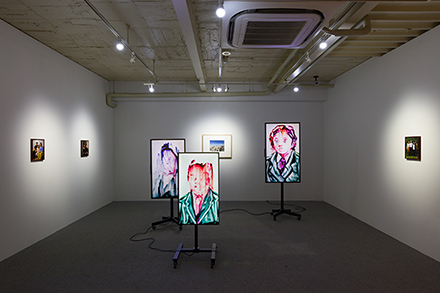
Portraits(ブエノスアイレス | 日系移民のポートレイト) 2019 液晶モニター、映像、インタヴューの音声、テレビスタンド、写真、その他
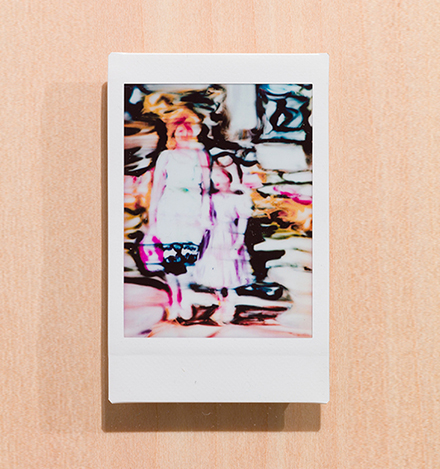
untitled album photo(Nikkei / Buenos Aires) 2019 instax(拡散現像方式印画)、合板、額
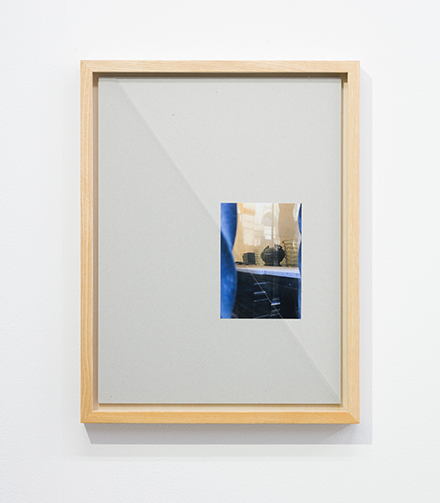
日時計(-34°) 2019 ボール紙、写真、三角形のUVカットアクリル、額

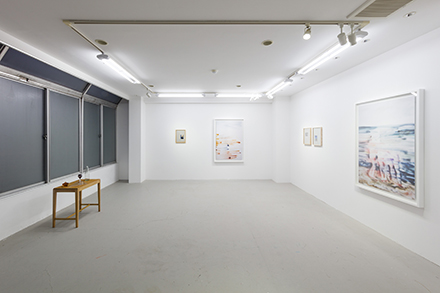
撮影:麥生田兵吾
|
| 全ての画像・テキスト・キャプション等の無断転載を禁じます . |
No part of these works may be reproduced or transmitted in any form or by any means without the written permission of Nobuyuki OSAKI |

